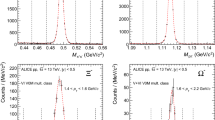Abstract
Pion electromagnetic characteristics such as electric polarizability and rms radius were calculated. Pions are considered a nonrelativistic system of two pointlike spinor quarks with a linear potential at large distances and a Coulomb one at short ones.
Similar content being viewed by others
References
R. Weiner and W. Weise, “Electromagnetic Polarizability of the Nucleon and Chiral Quark Models,” Phys. Lett. B 159, 85–99 (1985).
N. N. Scoccola and W. Weise, “Nonlinear Meson Theories and Electromagnetic Polarizability of the Nucleon,” Nucl. Phys. A 517, 495–508 (1990).
J. F. Donoghue and B. R. Holstein, “Pion Transitions and Models of Chiral Symmetry,” Phys. Rev. D: Part. Fields 40, 2378–2409 (1989).
B. R. Holstein, “Pion Polarizability and Chiral Symmetry,” Comments Nucl. Part. Phys. A 19, 221–238 (1990)
V. N. Pervushin and M. K. Volkov, “Pion Polarizability in Chiral Quantum Field Theory,” Phys. Lett. B 55, 405–408 (1975).
M. A. Ivanov and T. Mizutani, “Pion and Kaon Polarizabilities in the Quark Confinement Model,” Phys. Rev. D: Part. Fields 45, 1580–1601 (1992).
M. V. Terent’ev, “Pion Polarizability, Virtual Compton-Effect and π → eνγ Decay,” Sov. J. Nucl. Phys. 16, 87 (1972).
V. A. Petrun’kin, “Electric and Magnetic Polarizability of Hadrons,” Sov. J. Part. Nucl. 12, 278 (1981).
G. Dattoli, G. Matone, and D. Prosperi, “Hadron Polarizabilities and Quark Models,” Lett. Nuovo Cim. 19, 601–614 (1977).
D. Drechsel and A. Russo, “Nucleon Structure Effects in Photon Scattering by Nuclei,” Phys. Lett. B 137, 294–298 (1984).
F. Schoberl and H. Leeb, “Quark Core Contribution to the Electric Polarizability of Hadrons,” Phys. Lett. B 166, 355–371 (1986).
M. de Sanctis and D. Prosperi, “Nucleon Polarizabilities in the Constituent Quark Model,” Nuovo Cim. A 103, 1301–1310 (1990).
H. Liebl and G. R. Goldstein, “Electromagnetic Polarizabilities and Charge Radii of the Nucleons in the Diquark Model,” Phys. Lett. B 343, 363–368 (1995).
S. M. Kuchin and E. V. Vakulina, “Estimation of Valent Quark Contribution to Electric Polarizability of Mesons in Nonrelativistic Quark Model,” in Proceedings of the 12th International Scientific-Methodical Conference on Actual Problems of Science and Education problemy nauki i obrazovaniya (RIO BGU, Bryansk, 2009), pp. 62–73.
N. V. Maksimenko and S. M. Kuchin, “Static Polarizability of Mesons in a Quark Model,” Izv. Vyssh. Uchebn. Zaved., Fiz. 53(5), 99–101 (2010).
V. V. Andreev and N. V. Maksimenko, “Static Polarizability of Relativistic Two Particle Bound System,” in Proceedings of the International School-Seminar on Actual Problems of Particle Physics, Gomel, Belarus, 2001 (Dubna, 2002), vol. 2, pp. 128–139.
H. Tezuka, “Analytical Solution of the Schrödinger Equation with Linear Confinement Potential,” J. Phys. A: Math. Gen. 24, 5267–5272 (1991).
A. F. Krutov and V. E. Troitsky, “Relativistic Instant-Form Approach to the Structure of Two-Body Composite Systems,” Phys. Rev. C 65, 045501 (2002).
D. E. Groom et al., “Review of Particle Physics,” Eur. Phys. J. C 15, 1–878 (2000).
S. R. Amendolia et al., “A Measurement of the Pion Charge Radius,” Phys. Lett. B 146, 116 (1984).
A. I. L’vov, “Theoretical Aspects of the Polarizability of the Nucleon,” Int. J. Mod. Phys. A 8, 52–67 (1993).
T. A. Aibergenov et al., “Radiative Photoproduction of Pions and Pion Compton Scattering,” Czech. J. Phys. B 36, 948–951 (1986).
C. Berger et al., “Pion Pair Production in Photon-Photon Interactions,” Z. Phys. C 26, 199 (1984).
A. Courau et al., “Lepton and Pion Pair Production in Gamma-Gamma Collisions Measured near the Threshold at DCI,” Nucl. Phys. B 271, 1–20 (1986).
Z. Ajaltouni et al., “Pion Pair Production in Photon-Photon Collisions at DCI,” Phys. Lett. B 194, 573 (1987).
J. Boyer et al. (Mark II Collab.), “Two Photon Production of Pion Pairs,” Phys. Rev. D: Part. Fields 42, 1350–1367 (1990).
J. F. Donoghue and B. R. Holstein, “Photon-Photon Scattering, Pion Polarizability and Chiral Symmetry,” Phys. Rev. D: Part. Fields 48, 137–146 (1993).
Y. M. Antipov, et al., “Measurement of π-Meson Polarizability in Pion Compton Effect,” Phys. Lett. B 121, 445–448 (1983).
L. V. Fil’kov and V. L. Kashevarov, “Determination of π0 Meson Quadrupole Polarizabilities from the Process γγ → π0π0,” Phys. Rev. C 73, 035210 (2005).
J. Gasser, M. A. Ivanov, and M. E. Sainio, “Revisiting γγ →π+π−at Low Energies,” Nucl. Phys. B 745, 84–108 (2006).
V. V. Andreev, Poincare-Covariant Models of Two-Particle Systems with Quantum Field Potentials (Gomel’sk. Gos. Univ. F. Skoriny, Gomel’, 2008) [in Russian].
N. V. Maksimenko and S. G. Shul’ga, “Relativistic ‘Trembling’ Effect of Quarks in Electric Polarizability of Mesons,” Phys. At. Nucl. 56, 826 (1993).
S. P. Klevansky, R. H. Lemmer, and C. A. Wilmot, “The Das-Mathur-Okubo Sum Rule for the Charged Pion Polarizability in a Chiral Model,” Phys. Lett. B 457, 1–8 (1999).
U. Burgi, “Pion Polarizabilities and Charged Pion Pair Production to Two Loops,” Nucl. Phys. B 479, 392–426 (1996).
M. V. Terent’ev, “About Structure of Meson Wave Functions as Bound States of Relativistic Quarks,” Sov. J. Nucl. Phys. 24, 106 (1976).
M. J. Lavelle, K. Schilcher, and N. F. Nasrallah, “The Pion Polarizability from QCD Sum Rules,” Phys. Lett. B 335, 211–214 (1994).
W. Wilcox, “Charged Pion Polarizability from the Lattice,” Nucl. Phys. Proc. Suppl. 53, 302–304 (1997).
V. Bernard, “Pion Electromagnetic Polarizability and Chiral Models,” Phys. Lett. B 205, 16 (1988).
A. E. Radzhabov and M. K. Volkov, “Charged Pion Polarizability in the Nonlocal Quark Model of Nambu-Jona-Lasinio Type,” Part. Nucl. Lett 2, 1–3 (2005).
L. V. Fil’kov and V. L. Kashevarov, “Determination of π+-Meson Polarizabilities from the γγ → π + π − Process,” Phys. Rev. C 73, 035210 (2006).
Author information
Authors and Affiliations
Additional information
Original Russian Text © S.M. Kuchin, N.V. Maksimenko, 2012, published in Pis’ma v Zhurnal Fizika Elementarnykh Chastits i Atomnogo Yadra, 2012, No. 3(173), pp. 359–366.
Rights and permissions
About this article
Cite this article
Kuchin, S.M., Maksimenko, N.V. Pion electromagnetic characteristics in the quark model with confinement. Phys. Part. Nuclei Lett. 9, 216–219 (2012). https://doi.org/10.1134/S1547477112030107
Published:
Issue Date:
DOI: https://doi.org/10.1134/S1547477112030107




